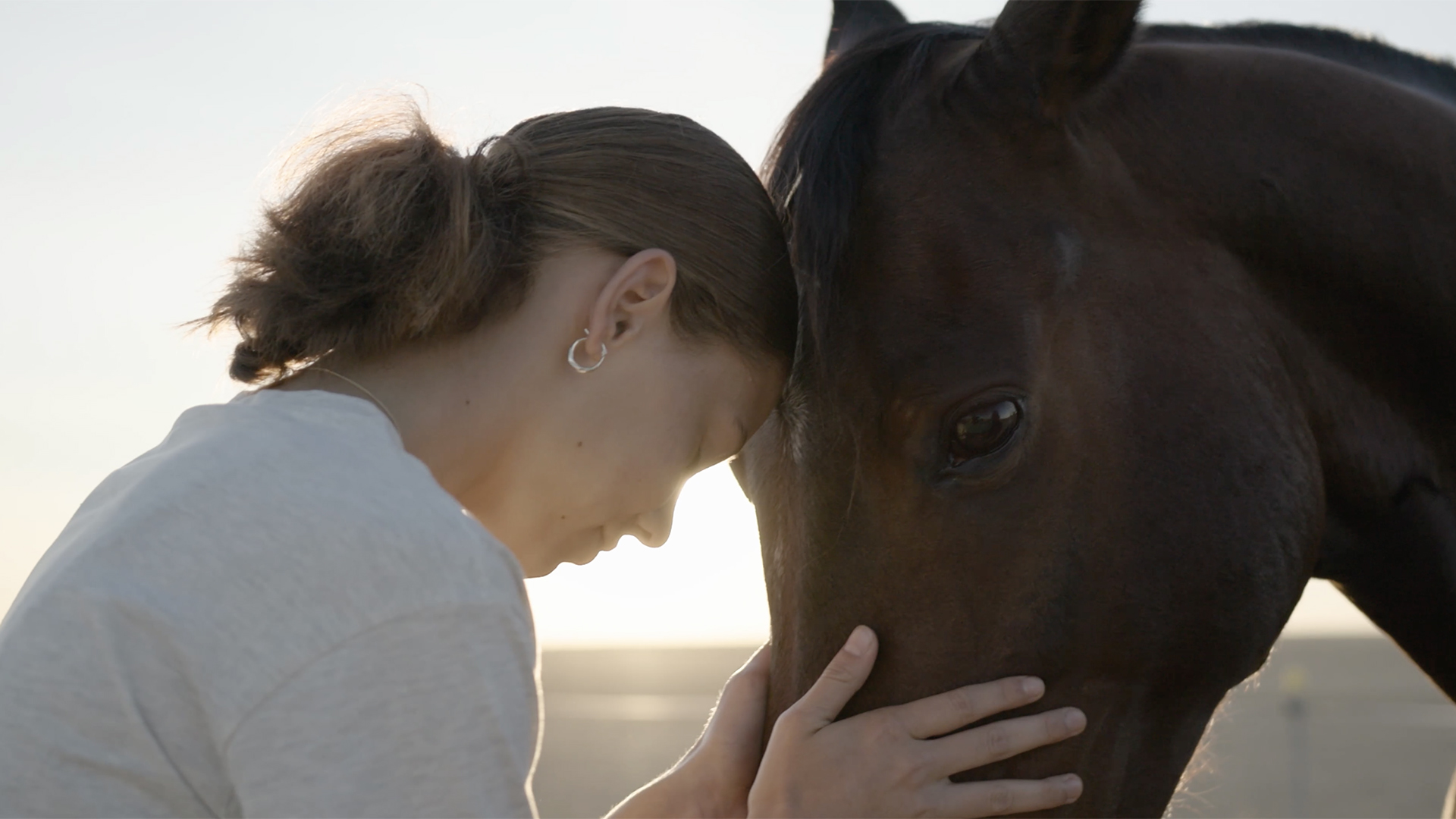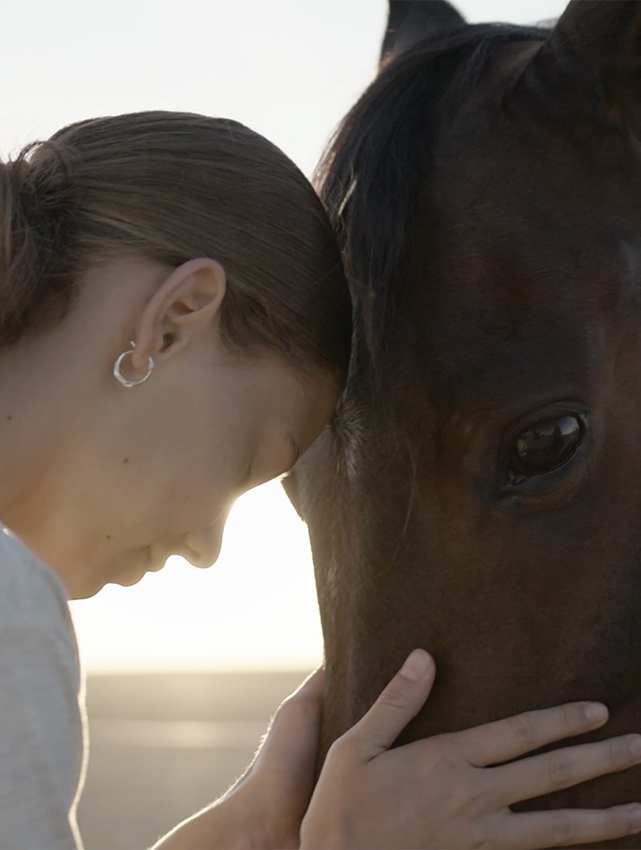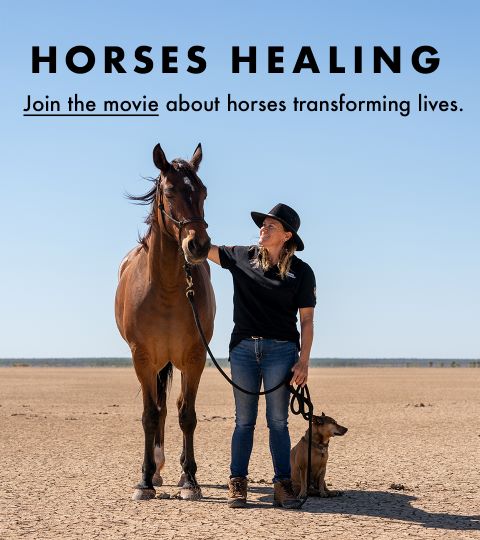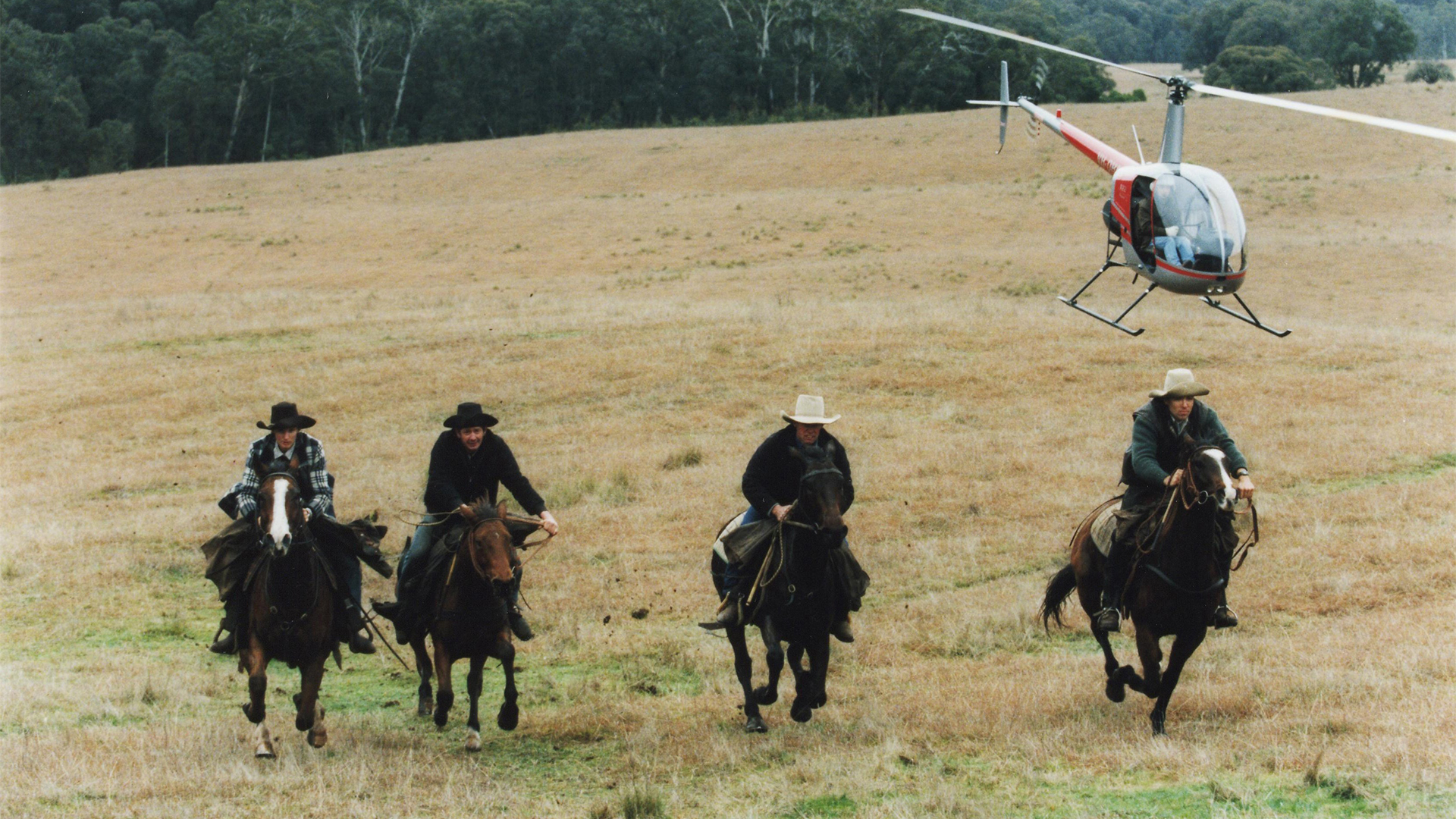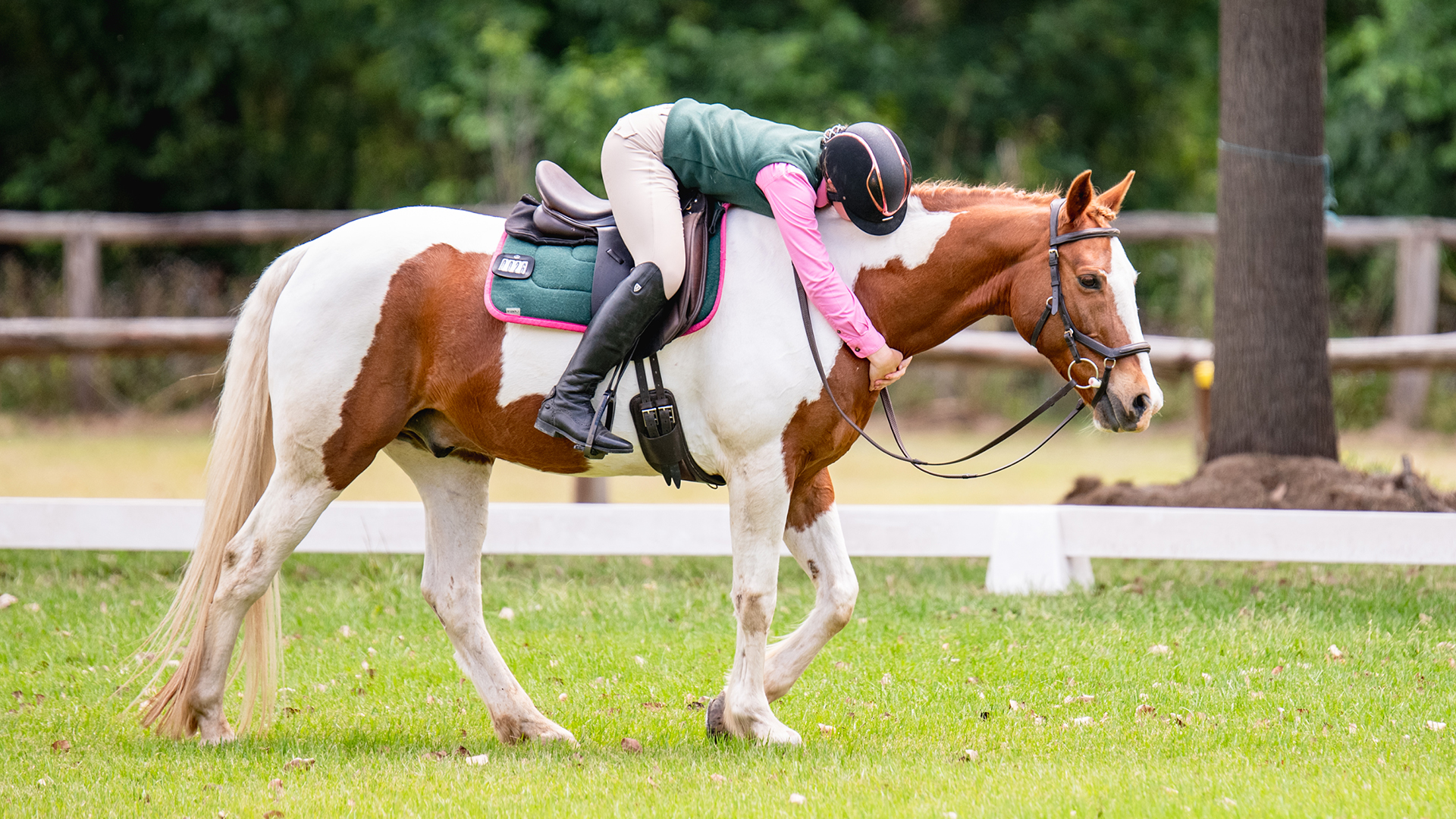When filmmakers Sean O’Reilly and Sophy Crane came across Yawardani Jan-ga, an equine assisted learning program for Aboriginal young people founded by Professor Juli Coffin, they knew it was a story the world should know about. A universal narrative of human and animal connection told through a uniquely Australian lens, they are now aiming to guide this story from Western Australia’s Kimberley to the bright lights of world’s top film festivals.
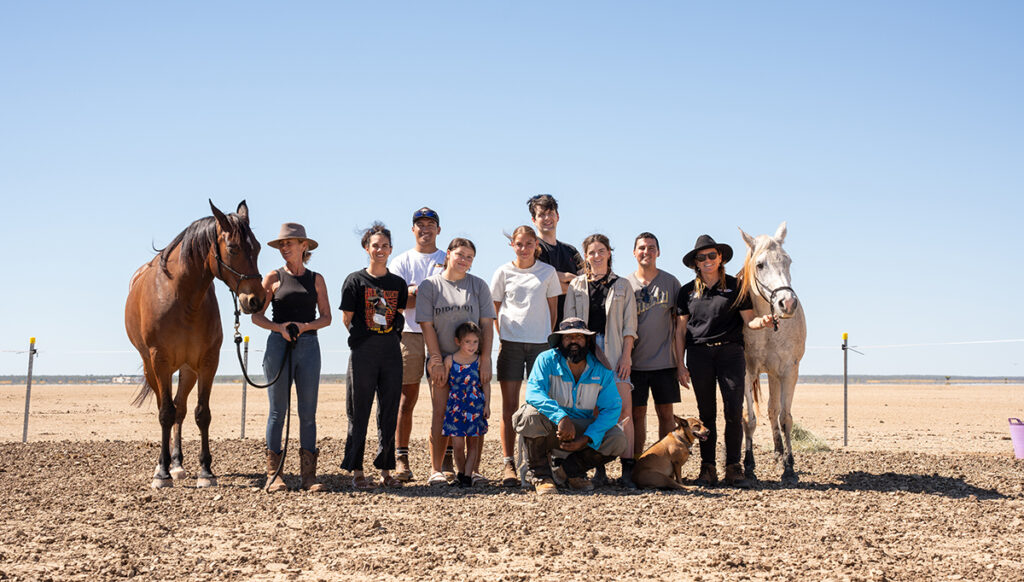
The film crew behind ‘Horses Healing’.
“They say filmmakers shouldn’t use their own money on projects, but we’ve gone completely against this advice,” admits Sean. Everything he and Sophy have achieved so far has been on their own personal spend, such is their belief in Professor Coffin’s work and the story they have to tell.
With most shooting now complete, the film has entered the production stage under the working title ‘Horses Healing’. Although there have been offers from production companies, the plan is to remain independent so the team retains the opportunity to release the film at a top tier film international film festival – such as the likes of Sundance or Toronto International Film Festival. The vision is clear: to share the story of Yawardani Jan-ga in a way that generates hope and positivity that celebrates the power of horses, the Kimberley, and the spirit of Aboriginal young people.
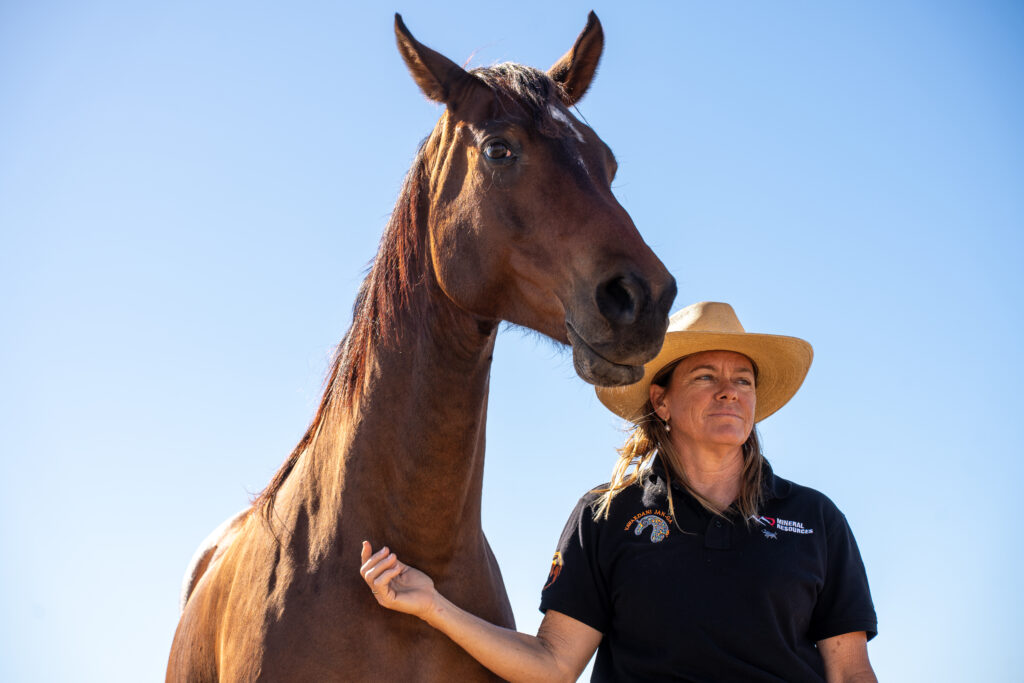
Professor Juli Coffin grew up in Western Australia’s Pilbara and has been around horses all her life. She currently runs Yawardani Jan-ga, an equine assisted learning program based in the Kimberly towns of Broome and Derby.
THE STORY BEHIND ‘HORSES HEALING’
Growing up in the Pilbara region of Western Australia, horses have always been in Professor Juli Coffin’s blood. Although obsessed from a young age, it wasn’t until her late 20s that she realised why they were such an important life influence.
“I was pregnant with my first child and had to send my horse away,” she recalls. “Even though I was occupied with having a baby, there was something missing; it was like leaving the house with one shoe. I realised it was horses, and from that point on I was intrigued by what it was they were offering me that couldn’t be replicated by anything else.”
With a university background in education and public health, Professor Coffin had long worked in those spaces and had over time begun to focus on supporting young Aboriginal people at risk – ultimately completing a PhD on the topic. Recognising the therapeutic benefits she’d gained from horses, she figured there must be a way to pull those elements together to provide the same benefits to others.
“I wondered how I could replicate some of what I had experienced and pass it on, and that’s where I started reading about that concept of equine assisted psychotherapy and equine assisted learning,” explains Professor Coffin. Looking at how equine assisted learning had been utilised around the globe to address trauma, her vision was for the horses to become part of a positive program aimed at early intervention.
Professor Coffin underwent training in equine assisted psychotherapy, and from there decided the best path forward was to fund a pilot program to demonstrate the benefits she knew existed.
BATTLE FOR FUNDING
Working in the state’s Mid West region with the Aboriginal Medical Service at the time, Professor Coffin’s funding requests for her pilot program were turned down time and time again until a tragedy within the local community resulted in an urgent need for change and intervention. With a year’s funding secured, the program was run from her property and 360 young people took part over 12 months. It was a success and won support among the local community, however, at the end of the year funding dried up and with a university job offer in Broome, Professor Coffin headed North.
She knew the program would benefit young people of the Kimberley, but it took another three years before it could again attract any sort of funding. Fortunately, her scientific background came to the fore, and with the program written up as a research proposal, she gained traction. “That’s when I started to get interest and was very fortunate to crack a couple of good grants and some strong philanthropic support. Because I’d experienced the power of horses personally and had also been able to do the pilot, I could use that evidence to justify why it would be of benefit.”
In 2018, Yawardani Jan-ga – “Horses Helping” in the Yawuru language – welcomed its first participants. Six years on, over 2,000 Aboriginal children and young people have been through the program operating out of locations in both Broome and Derby. It’s gained unwavering support from local communities, however the push for ongoing funding has always been a battle.
Professor Coffin is pragmatic; there is no silver bullet that will solve all issues faced by the region’s young people, but she does believe that when run closely with community and in a culturally secure way, equine assisted learning has the capacity to make a real difference.
Despite limited funding, the program has an amazing human team behind it – from university staff on the research side, to equine assisted learning practitioners – all of whom are Aboriginal. To date, the program has trained 39 practitioners, nine who are currently actively delivering Yawardani Jan-ga equine assisted learning. With plans for new program sites in Fitzroy Crossing and reinvigorating Halls Creek, employment opportunities for locals are an added benefit.
THE POWER OF THE HORSES
As equestrians, we know the benefits horses offer us – however, for those who have never experienced an equine bond, the concept of horses healing humans is somewhat intangible; it’s difficult to explain verbally or textually. It’s something you need to see and experience with your own eyes.
“It’s everything,” says Professor Coffin of how horses can help us heal. “There are elements of unconditional love and acceptance that young people sometimes haven’t experienced much of. Horses step in and provide a proxy for that, and although we know that a horse can’t, for example, be a parent, they can still provide consistency, stability, boundaries… they can provide all those elements of really good relationships and they model that every day in the way they are in the world.
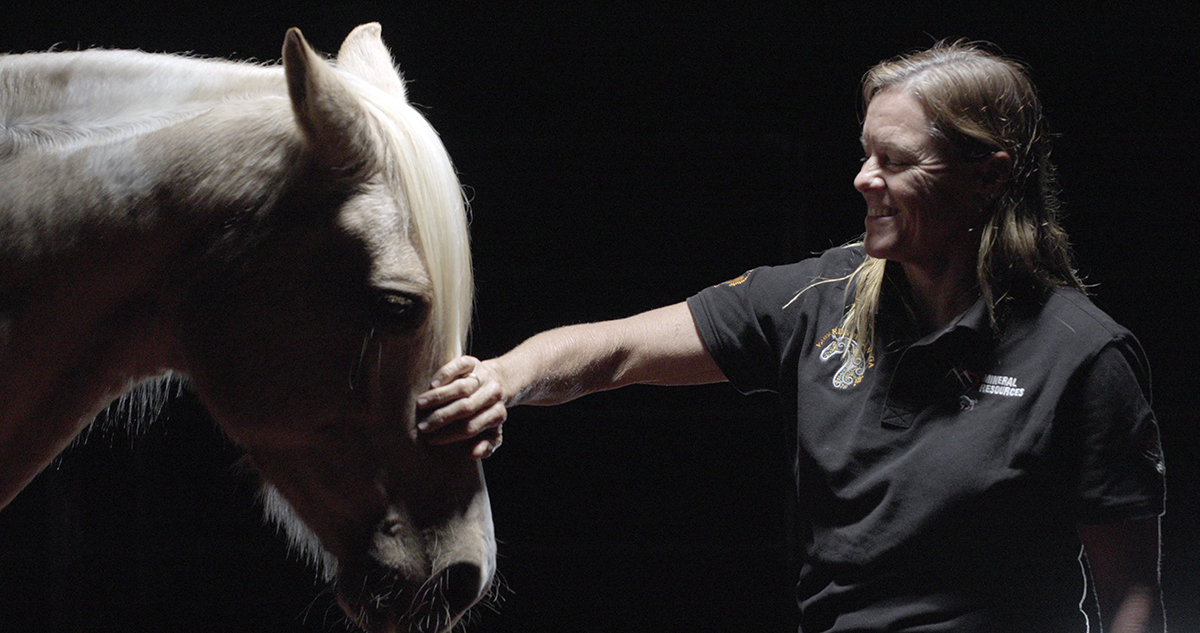
Professor Coffin believes the power of horses lies in their ability to reach the inner person.
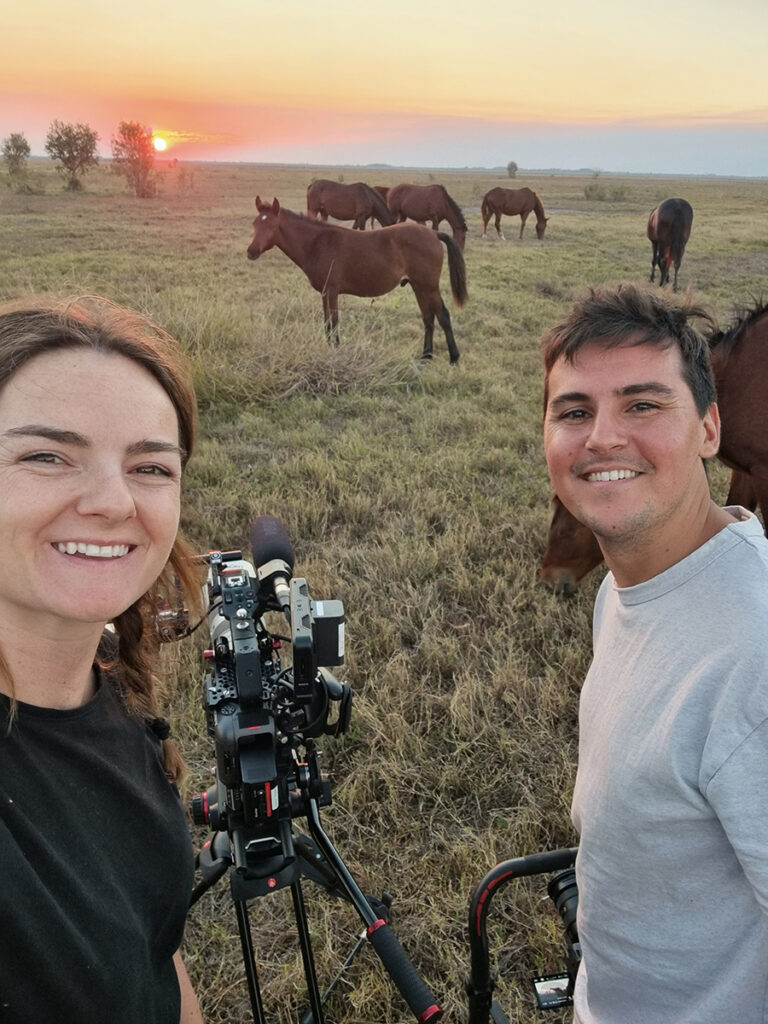
Sophy Crane and Sean O’Reilly.
“That’s the power of the horses… they get to the inner person. You can’t bluff a horse because it’s based on feeling, not words. We humans don’t naturally tune into that; that’s not the way we go in the world. We look at face value, we look at words… whereas horses look and listen in a different way.”
Professor Coffin knew that once she could demonstrate the benefits – once people witnessed it with their own eyes – they would see the value. “Once someone’s been here and visited, they become real advocates for the work and start supporting us. They see it as a valid opportunity to support, nurture and heal our Aboriginal young people before they reach adverse trajectories. However, being based in the Kimberley, we can’t physically get everybody here. Visual representation through film, that’s the next best thing.”
A LOVE OF ANIMALS
Cinematographer Sophy Crane is no stranger to horses. Growing up on a farm in the UK, she rode from a young age and was an amateur eventer. While in her final year of studying biology at university, a BBC representative offered a module in scientific communication. It detailed how to get science into film and make it more accessible for the average person, and Sophy was hooked.
“I fell in love with filmmaking and how it can make these very complex subjects easy for people to understand,” she explains. Sophy moved to Australia in 2018, where she met Sean and together they set out to make documentaries.
Sophy first discovered Professor Coffin’s work when she stumbled across the pilot program research paper. “We then found and listened to a podcast and thought Juli was amazing. We had to contact her,” recalls Sophy.
Two years and hundreds of emails later, Sophy and Sean landed in Broome to spend three months filming from April to June this year.
“Sophy and I have always had an interest in natural history, particularly in stories where there is a unique human and animal bond,” explains Sean. “As storytellers, we are attracted to tales that the world can feel and connect with.
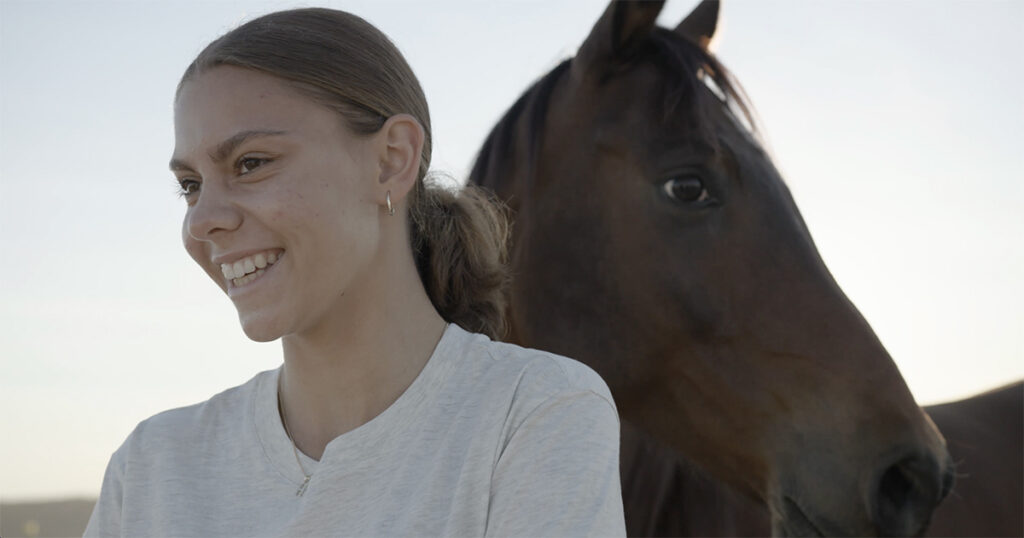
Filming followed multiple young people documenting their journey over three months.
“Our First Nations people, their voice has been taken away; the horses offer a pathway back to some truth. The story is of young people who are unsure of their place in the world, and the meeting place that Professor Coffin has created where they can reconnect with a truth that has been lost.”
Unlike Sophy, Sean didn’t have much experience with horses until he connected with Professor Coffin. However, he did get in the saddle once while filming gauchos in Argentina: “I’d never been on a horse, and the film crew put me on one with my camera… it bolted. That was the only experience I had before filming at Yawardani Jan-ga.”
After three months of filming Professor Coffin’s program in the Kimberley and spending time with the horses, Sean now is passionate about them.
IMMERSED IN THE KIMBERLEY
“We really immersed ourselves in the Kimberley, specifically Broome,” explains Sean. It was both his and Sophy’s first time in northern WA, and they were blown away by the landscape.
“Everywhere we’d point the camera, it just looked incredible. All the red dirt… I couldn’t get over that,” recalls Sophy of her first impressions.
It wasn’t just the landscape that took their breath away. Filming followed multiple young people, documenting their journey over three months; what Sophy saw through the lens changed her perception of the relationship between humans and horses forever.
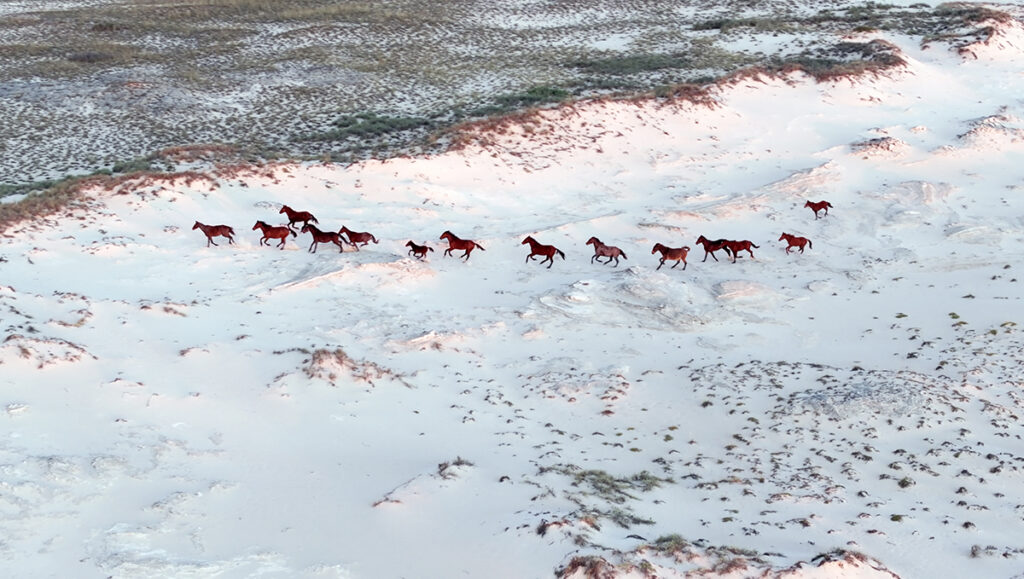
Sophy and Sean immersed themselves in the Kimberley for three months. In addition to filming at Yawardani Jan-ga, they also spent time capturing footage of local brumby herds.
“A horse’s presence can be powerful; even just standing with them in silence. It was amazing to see Juli harness that – I’d spent much of my life with horses, but those partnerships were always competition focused. And while I loved them, I’d never thought about them in the way Juli does. There’s this whole other world out there with horses; they can really unlock things for people, and often in a way many involved in the equestrian industry may have never experienced.”
Yawardani Jan-ga’s equine team includes a variety of breeds, although the preference is usually part-Arabian as they cope best with the climate. Some are purchased, while others have been donated or rescued. With a wide variety of horses, the program participants have a choice of who to work with; like humans, horses too have different personalities and Professor Coffin has found that participants often click with a certain horse.
Not far from Yawardani Jan-ga, herds of brumbies have existed on Broome’s harsh salt flats for many years. Involved with the local brumby rescue group for more than a decade, Professor Coffin hopes some of the foals will eventually be trained to join the program. Sophy and Sean became captivated by these local residents and spent time watching them behind the lens, filming them regularly at sunrise and sunset. The plan is for this footage to illustrate a side story within the film of an injured foal that is rescued and cared for by the local community; the scenery alone is breathtaking.
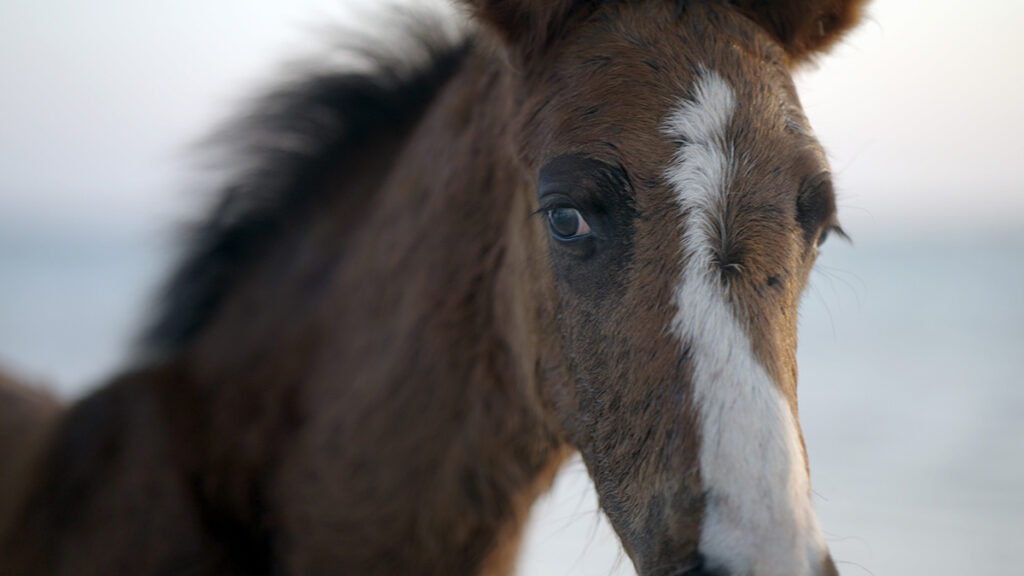
The side story of a brumby foal is likely to feature in the film.
For Sophy, one of the challenges of filming footage of the program in action was to capture the story without influencing it; when you’ve got horses and bulky camera equipment involved, that is easier said than done.
“As a filmmaker, I’m always very cautious of not getting in the way or disturbing people – especially kids and horses. I had a bloody great camera with the big lens on it… I looked like a ridiculous turtle walking around!” she laughs. “We used a long lens so I could film from afar and not disturb the horses or the kids; I was never in the ring while a session was running.”
Although Sophy was filming from a distance, being a horse lover at heart it wasn’t long before she made her own connection with one of the horses. “I loved this little mare named Maisey. Every time I’d come in, she’d always pop her little head out and say hello!”
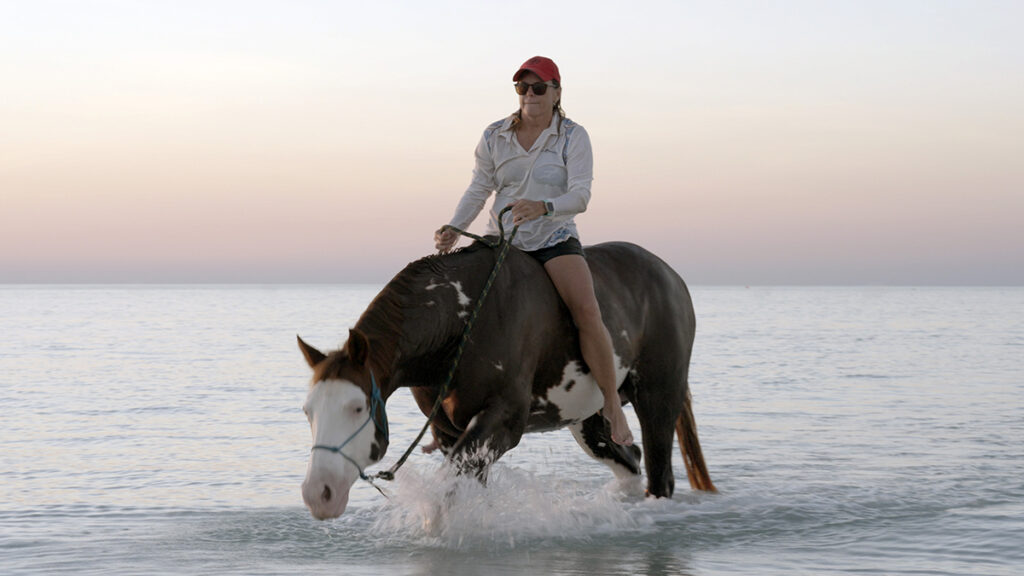
Professor Coffin, pictured here with one of the program’s horses, says she felt quite emotional when watching the first glimpses of footage.
FIERCELY INDEPENDENT
“Sophy, Juli and I have been fiercely wanting this to remain independent. We want this to be a hopeful story; it must empower and celebrate people,” explains Sean.
With the sizzle complete, Professor Coffin has had her first glimpse of the film for which she will be listed as the Executive Producer. “I felt quite emotional watching it,” she says. “It’s a lot visually to take in, and for me to feel that emotion – as someone who sees that stuff every day – was special. I felt very reassured… it was exactly how I’d envisaged it and I feel it’s going to capture those important elements.
“I hope that it sends a message that there are alternative ways to support our Aboriginal young people, who have been crying out for something different for a long time. I hope it encourages people to not be dismissive of alternative therapeutic approaches, and helps them recognise that horses hold so much untapped power and potential.
“I hope that it’s going to have the impact that we believe it can have on those who have never experienced horses… as well as those who know horses but don’t know this side of them. If people can better understand the benefits of horses and lean into them, we wouldn’t have the struggles that we do for ongoing funding. We’ve had 2000 Aboriginal young people participate in one form or another since 2018 with pieced-together funding; if we had ongoing, secure funding, what would that look like?”
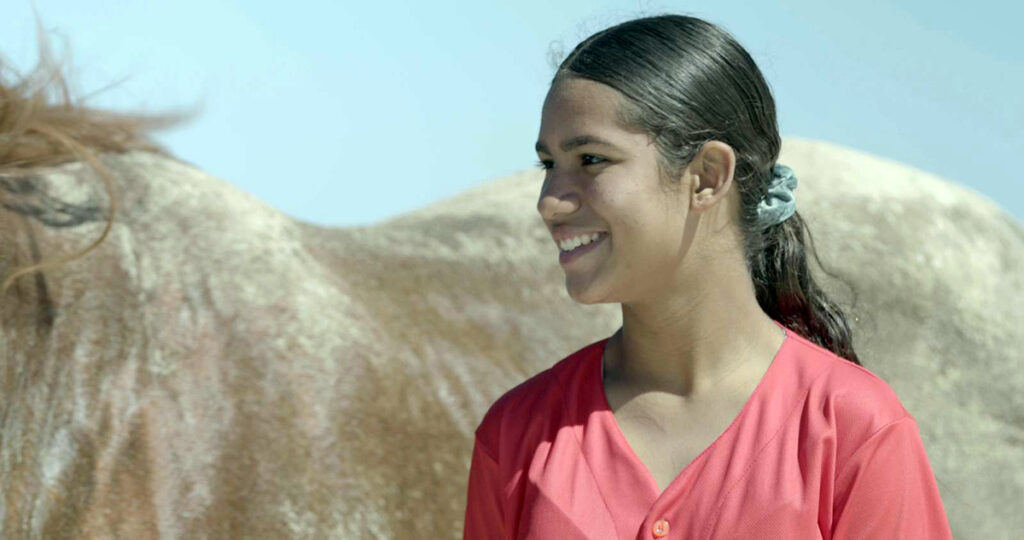
Sean and Sophy’s goal for the film is to support Professor Coffin, the program and its participants.
VISION FOR THE FUTURE
Professor Coffin’s vision for the future is the ability to provide the program everywhere it is needed. “We get a lot of requests to replicate Yawardani Jan-ga throughout Australia; we’ve had requests from just about every state, as well as Palm Island.”
However, it’s not as simple as bringing horses and kids together; to make the program successful and viable in terms of funding, there needs to be a structure in place that delivers measurable results. “There has got to be outcomes,” she explains. “The way we measure the work is through video and photo, and that’s why having a film reflect what we do is so perfect.”
Sean and Sophy are unwavering when it comes to the film’s primary goal: they want to support Professor Coffin, the program, and its participants. “Having this film illustrate the work Juli and her team are doing, and providing evidence of the benefits… it positions equine assisted learning as an accessible, natural and potentially better pathway to finding your voice,” says Sean.
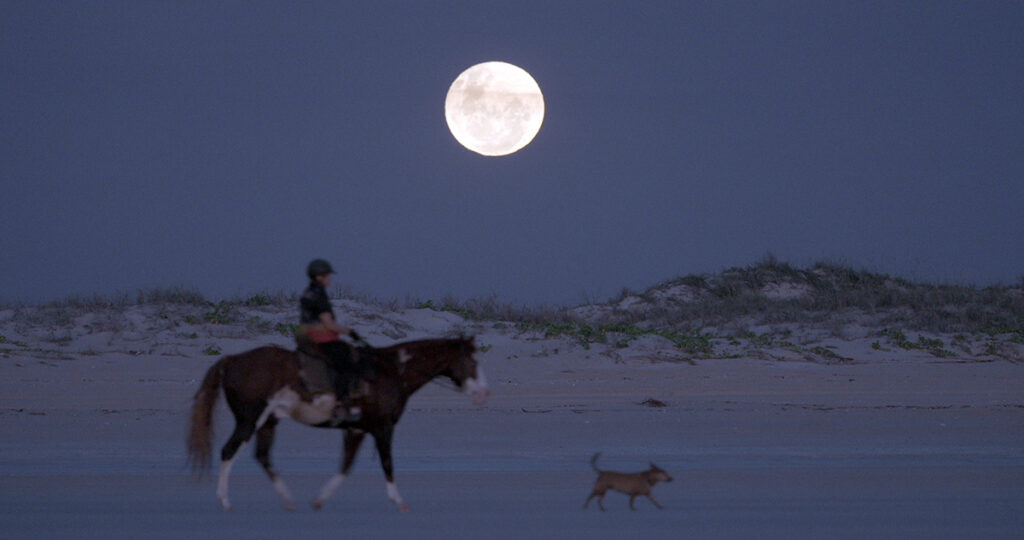
Sean and Sophy hope the film may be accepted to premiere at the 2025 Sundance Film Festival.
“Juli is a truly amazing Australian hero. When Sophy and I were in Broome, it’s hard not to see the impact this program is having within the community. It’s profound.”
Beyond raising awareness here in Australia, Sophy and Sean hope their film can also resonate on the world stage. “While it portrays Australia and speaks uniquely to Australians in that way, there’s definitely huge international opportunity and appeal. The connection between human and animal exists all around the world, and the Australian outback is a globally recognised symbol,” explains Sean.
“People who love horses know there is something about the bond they share with them; they feel that. This film aims to show, very tangibly, how that bond is working and how we can see it benefitting young people who need the ability to find their own voice. The story of a life changing connection with a horse is something that is not limited geographically; our aim is a universal story.”
Join the journey by visiting HorsesHealing.com.au
